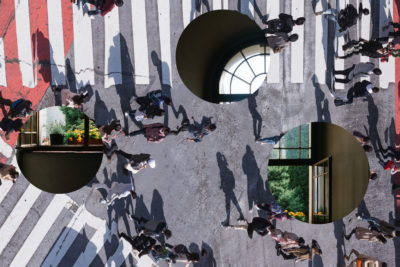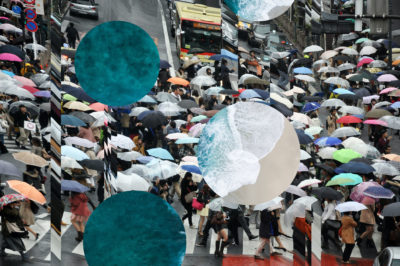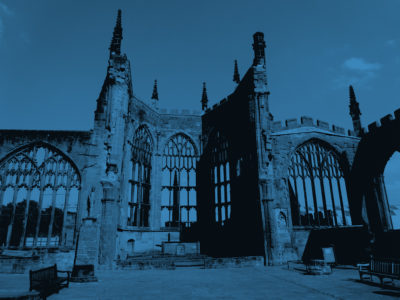Read this article in the limited edition print version: order a copy here.
“As I went into the ruined cathedral on the morning after the destruction, there flashed into the mind the deep certainty that as the Cathedral had been crucified with Christ, so it would rise again with Him. How or when we could not tell; nor did it matter. The Cathedral would rise again.”
These are the words of Provost R.T. Howard on the morning of the 15th November 1940. Only the tower, spire and outer walls of the 14th century Cathedral in Coventry had survived the Luftwaffe bombing raid which had also claimed the lives of nearly six hundred citizens.
The destruction of old St. Michael’s was deplored universally as an act of “cultural vandalism”, because the destruction of this rare artefact, in effect and in time, was understood to be more than just the loss of bricks and stones. The anthropologist Clifford Geertz described the explicated qualities of culture as: “a historically transmitted pattern of meanings embodied in symbols, a system of inherited conceptions expressed in symbolic forms by means of which people communicate, perpetuate, and develop their knowledge about and attitudes toward life.”
This idea of ‘crucifixion of place’ is a recognition that an injustice has been committed against both the living and the dead, and those yet to come.
Artefacts and places bear the mark and memory and meaning of a people. In secular terms cultural vandalism can be understood as an offense against humanity because it results in the erasure of the memory of cultural assets and the effacing of the identity of their creators. Indeed, the destruction of cultural heritage is sanctioned as a crime by the Hague Convention for the Protection of Cultural Property in the Event of Armed Conflict of May 14,1954.
For Provost R.T. Howard, to say that the Cathedral had been “crucified with Christ” was an explicit and perhaps perplexing “confession of faith”. This framing of an experience of destruction in the language of faith was echoed on the other side of the city, on that same day, as Dom. Sebastian Simpson OSB was clawing through the charred ruins of St. Osburg’s Church to retrieve the Tabernacle. He wrote: “Our Lord must leave his Temple in which for nearly 100 years He had been adored and where He had fed with His own Body the souls of countless (people). Did the thousands of Faithful Departed who once worshipped here…witness this departure of His? One imagined all of them uttering the lamentation of the Magdelen of old – ‘They have taken away my Lord’, and hoped their prayers would help to bring Him back again.” For Simpson, the destruction of his Church was a “Mary Magdalene moment”.

Bearing the Marks
This idea of the “crucifixion of place” is more than just a metaphor. It is a recognition that an injustice has been committed against both the living and the dead and those yet to come. The identification of destruction as a “crucifixion” is a paradoxical, faith-filled statement of solidarity with the “scandal” that is the Cross of Jesus.
Passionist scripture scholar Donald Senior comments: “Because Jesus was innocent and just, his death on the cross was an act of supreme injustice, an act of violence and oppression whose roots are radically evil. Because his mission of justice led to his death, the cross also stands, therefore, as a sign of condemnation of all injustice and oppression, of all infliction of violence and suffering of the innocent.”
So in the January of 1941, Provost Howard asked the Cathedral’s stone mason to make an altar from the rubble and place behind it a cross made from two charred oak beams that had fallen from the roof. This burnt cross has become the focal point of the ruins ever since and stands “as a sign of condemnation of all injustice and oppression.” This cross also stands alongside the new Cathedral which arose out of the ashes, as Provost Howard prophesied, but this new Cathedral still bears the marks of that “crucifixion”. The charred cross witnesses to an act of injustice but it is also a sign of hope and Resurrection. For Donald Senior to encounter in faith “crucifixion” in the violence and injustice of human experience is to be “a community that is, in fact, the body of the Crucified Christ who is triumphant but still bears the wounds of his cross, a community able to give a witness of hope and meaning to the world.” This witness happens in time and culture and place.
Related Stories

Experiences of Passionist prayer, pt. 3: Joanne Crompton
How do we pray? What role does prayer take in our lives? We asked three people pursuing a Passionist spirituality how their sense of prayer has changed over time.
Jul 05 2023

Experiences of Passionist prayer, pt. 2: Bishop William Kenney
How do we pray? What role does prayer take in our lives? We asked three people pursuing a Passionist spirituality how their sense of prayer has changed over time.
Jun 24 2023

Experiences of Passionist prayer, pt. 1: Michael O’Halloran
How do we pray? What role does prayer take in our lives? We asked three people pursuing a Passionist spirituality how their sense of prayer has changed over time.
Jun 18 2023




